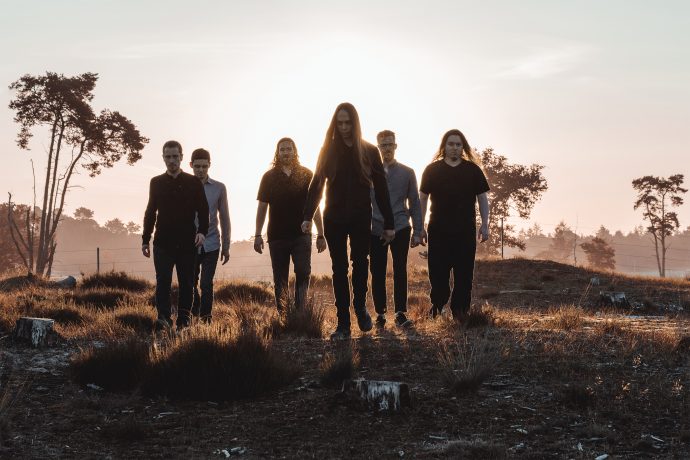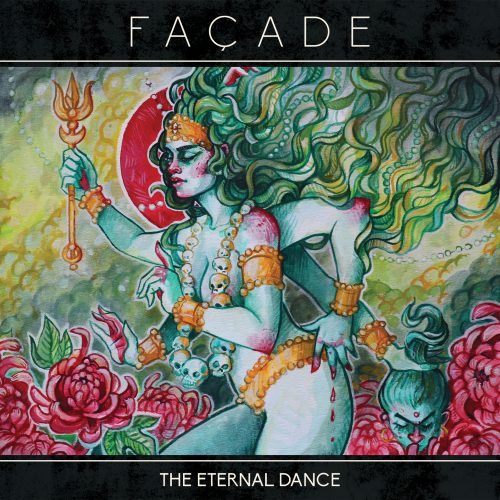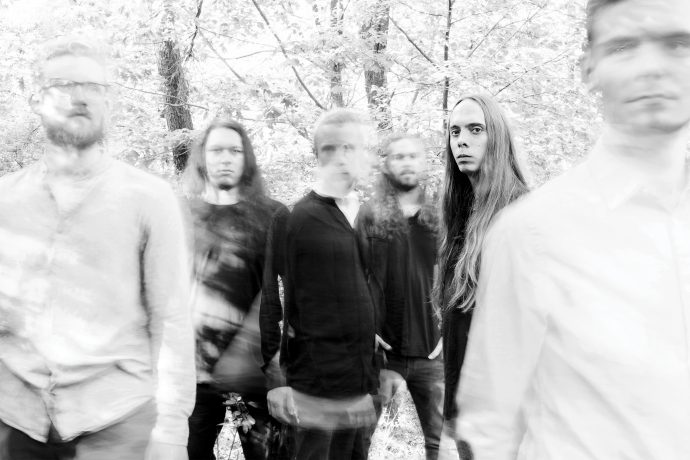(In this new interview Comrade Aleks presents a discussion with Pim van Dijk, bassist of the Dutch band Façade, whose new concept album The Eternal Dance will be released on November 29th.)
Dordrecht, South Holland, seems to be a nice place: a lot of ancient buildings, museums, and a National Park alongside swamps in the vicinity… Façade was founded there in 2011, and since then the guys have performed their depressive and quite intricate doom/death metal. At least we could tell that in 2017 when they released their debut full-length Loathe, and now the gents have new material, and things turn to be even more complex.
Façade’s forthcoming album The Eternal Dance not only shows development of the ideas they represented two years ago, but this album also has a thoughtful concept and a more varied sonic palette, as these compositions sound richer and naturally deeper than Loathe. The band grows, it’s good…
Why not discuss these topics with one of its members? Pim van Dijk (bass) is on duty today.
******
Hi Pim! We spoke less than two years ago, I believe, but it seems you were busy all the time. Are you focused on conquering the local doom scene or do you just need to re-channel your creative negativity?
Yes, we were very busy at that time. If I recall correctly, we were already pretty far into writing The Eternal Dance. But with that done and the album release on the 29th this month, our focus now is to spread the word about our new album and play shows. We haven’t been doing a lot of gigs for the past two years — so far we’ve only done one this year I believe!
Can you already tell the name of the label who will take care of The Eternal Dance? Oh, wait, it’s self-released, right?
Yes, we are releasing The Eternal Dance independently. Partially due to my stubbornness for wanting to release our art on our own terms, but also because we thoroughly enjoy the whole process of it. It’s a lot sometimes, but it’s also very rewarding.
Do you work with some promo agency? There are guys out there who help bands and labels to spread the word more effectively.
We do actually! We sided with a PR agency to help us do some online campaigning and get the word out about our new album. That takes a big chunk of work off our shoulders, and these people have a lot more reach than we do, of course! I’m curious to see how that will work out for us.
So you’ve taken part in a split with Locus Amoenus, released by GS Productions in March 2018. Who was the author of this idea? You or the label?
I think the idea came from Mees, the creative mind behind Locus Amoenus. He thought our initial EP was pretty cool, but since it was never released on CD, suggested we should do a split. We took the opportunity to revisit the mix of the material in order to give the release an exclusive edge.
Locus Amoenus performs kind of a blackened form of doom metal. How often do you share the stage with more extreme bands?
Well, like I mentioned earlier, we haven’t been playing a lot of gigs lately. But our first gig this year was with Hibakusha, an impressive technical metal band with a very modern sound. The 29th, at our release show, we’re sharing the stage with Cthuluminati, a blackened metal band with some avant-garde elements in there as well. We also played the Into Darkness festival, which is mainly black metal. I like sharing the stage with varied acts, it’s inspiring.
Facade – Unmade
Then you took part in a cover recording of Officium Triste’s “This Inner Twist”, which is included in the tribute Born To Lose, Doomed To Die. What was your first encounter with the band? What drew you to the song you covered?
Officium Triste are good friends of ours. We’re all from the same area and one of our first gigs was also with them. Ben chose this song because it means a lot to him personally, so we agreed on it, and of course we tried to honor both Ben and Officium Triste by making our own version.
Did you aim to sound like Façade or like Officium Triste in recording this track?
Naturally we aimed to sound like us, while still paying homage to the original. Our version opens in a way which closely resembles the original, but halfway through we turn the whole thing upside down. It was a really fun thing to do, and I quite like the result.
How do you see the role of Officium Triste for the Netherlands scene?
They’re definitely a big name in the Dutch scene, one of the pioneers. They support new bands entering the niche of death doom by joining them on stage and collaborating on new releases. It’s an important role since the scene is so small; we have to work together and we really appreciate their efforts in that regard.
I don’t remember if I ever asked you this strict question about your own musical influences – which bands shaped your feeling of doom metal’s aesthetics?
Honestly, we all listen to a wide variety of music. I think what makes doom metal stand out is the atmosphere it tries to capture, which makes it a genre with a lot of variety.
As far as metal goes, for me personally Opeth did a lot – I love their new album by the way – and according to Spotify, Gojira, Tool, and Leprous are my favourite artists, but what I’m experiencing in doom really transcends beyond metal.
I hear plenty of songs that aren’t metal at all that make me go like “wow, this has a very heavy, doomy vibe.” Songs like ‘I’m So Afraid’ by Fleetwood Mac, ‘You Want It Darker’ by Leonard Cohen, and ‘Epitaph’ by King Crimson. I can listen to musicians like Eivør, Tori Amos, Roger Waters, and hear them play or use sounds in a very specific way that just inspires me so much, and they are far from metal musicians!
Your forthcoming album The Eternal Dance has a cover dealing with Hindu beliefs and at least one new song ‘Moksha’ (though I believe others as well) has a connection with its religious system. Is it a concept album?
It is a concept album, yes, but it is more about the symbolism and mythology that Kali represents rather than an actual religious system. Kali represents both birth and death. Life starts with her and it also ends with her. The album is really about that cycle of life and death.
The title was inspired by the idea that our lives, our ideas, and all the things that surround us are just small motions in a larger movement: a never-ending dance that is the Universe itself. One motion ends, but a new one follows up to continue the dance. One life ends, but a new life is born.
But you know, as human beings we can have that feeling of being stuck at certain points or phases in our lives. We might have developed habits that do not bring us joy or happiness, yet we hold on to them. The only way forward from such a vicious cycle—the feeling of being stuck, or held down — is to “just quit”, distance yourself, and allow for something new to begin. That process may be very hard and painful, but sometimes that metaphorical death is the only way forward. So in a sense, the message of the album is quite positive.
How do you see your interest towards doom metal from this point of view? Is it a habit or obsession? By the way, I wouldn’t get that it’s Kali, too sexy and ain’t that black.
If by “habit or obsession” you mean the lyrical themes of doom metal or metal in general, I’d say, yes. I think a lot of metal is obsessed with extreme emotions, but it’s extreme music, so if there is a place for these sorts of things it’s definitely metal music. However, it’s not how I experience life at all, so I don’t write like that. Sure, everybody experiences strong emotions, but they do not define you. They’re passing moments, just like the motions of a dance, and if you decide to stay with one of those motions you’re not continuing the dance, you stop the dance and then you’re stuck.
The concept of The Eternal Dance is the continuity of things – not the end of it all – and we wanted that represented in the art as well. Tanja Poot’s art is vibrant, lively, and feminine and complements that concept perfectly. She really read up on Kali’s mythology and incorporated all the symbolism associated with Kali into her art. The aspects associated with Kali as a goddess of death and destruction are still present, but she put emphasis on Kali as a mother goddess, a giver of life. She’s softer, she’s desirable, and she blesses new life in the form of a flower.
There’s a plethora of depictions of Kali; we could’ve gone for the dark, terrifying Kali, with blood, skulls and demons, and we’d undoubtedly have a very “trve” album cover, but also one that’s a dime a dozen, I think.
Well, I can’t argue with that! Why did you choose these images for the new material? Were these texts initially part of your plan or did the music come first?
The lyrics and music really came kind of hand-in-hand.
I wanted to write a heavy, atmospheric, metal album that shines a different light on Death. It’s very metal to write about satanism and demons, a still recurring theme in metal, but those things are only scary if you actually believe in them. In the ’90s they had shock value, but that is no longer the case, I believe.
A lot of doom metal has the tendency to focus on endless suffering and grief, also in a very dualist way of thinking, and like I said earlier, that doesn’t reflect the reality of life in my experience. Life isn’t black and white, it’s a lot of subtle shades. And while it’s perfectly alright to experience those extreme feelings, I believe there should come a point where we decide to move on from that phase and free ourselves from it—allow ourselves to feel the subtleties of life again.
Great answer indeed! One of your new songs, ‘Moksha’, has a pretty long speech sample in its introduction. From where did you take it?
They are taken from a lecture by Alan Watts. He was a 20th century Zen philosopher and in this lecture he talks about his thoughts on death.
‘Moksha’ is Sanskrit for liberation and freedom and represents the release from this cycle of death and rebirth.
How do you see the interaction of the music and lyrics in The Eternal Dance?
The lyrics of each song are tied to one of those phases of birth, death, and renewal, and the instrumentation emphasizes that. The album opens up in a vast, empty space out of which new life is born, filled with energy, but as the album progresses the energy of the songs sink into a more dragging, sluggish atmosphere, carrying all the weight we collect on one’s back. This comes to a climax in the song ‘Death’, which is also where the cycle is broken and a new one begins.
Facade – Forlorn
Netherlands seem to be one of the first countries which gave birth to death doom metal, as there was a bunch of such bands in the late ’80s like Delirium, Mourning, Phlebotomized, and more. Most of them are unknown nowadays — what do you think about this phenomenon?
Death Doom is certainly no ‘pop’ music. Even within the metal scene it is a bit of a niche genre. Death Metal is typically a kind of music where the listener is bombarded with stimulants: blast beats, heavy riffs, fast solos: every part of the music is designed to surprise you and keep you entertained. Death Doom is kind of the introverted sibling to its extrovert brother Death Metal: instead of bombarding you with stimulants around every corner, it tries to induce a meditative kind of experience. Longer songs, slower riffs, wailing guitar solos. I guess that this combination of traits requires a bit more effort and dedication from the listener, which is hard to come by in a day and age where new inputs and stimulants are available right at your fingertips, waiting for you to stream into your ears.
Gladly, there are still lots of people who do appreciate this cocktail of introspective heaviness. For us, this balance between keeping the listener engaged, while also allowing the listener to lose oneself in the music, is exactly what we’ve aimed for with The Eternal Dance and we hope it shows!
Thank you Pim! I guess a too-extended interview would break the introspective nature of doom, so let’s not contradict this rule! That’s all for today, thanks for your time… Though have we forgotten something?
I don’t think so, thank you for your questions!
https://facadedoom.bandcamp.com/
https://www.facebook.com/facadedoom



